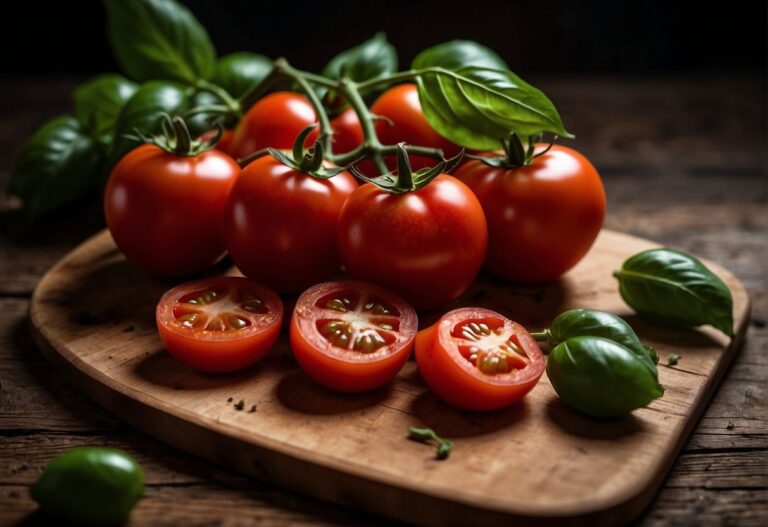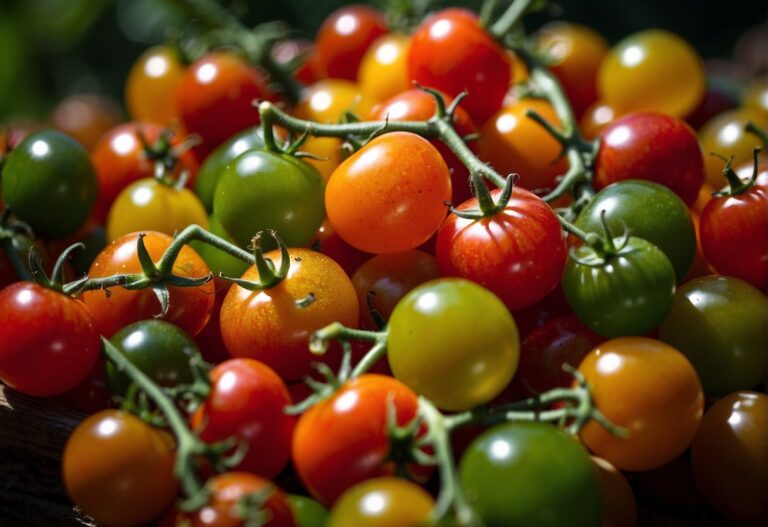Tomato Confit: A Guide to Perfectly Preserving Flavorful Tomatoes
Tomato confit is a delicious and versatile dish that showcases the natural sweetness of tomatoes through a slow cooking process. You can use it as a topping for crostini, a flavorful addition to salads, or as a sauce for pasta, making it a fantastic option for many meals. The beauty of tomato confit lies in its simplicity and rich flavor, achieved by using just a few ingredients like olive oil, garlic, and fresh herbs.
This classic French dish can be made with various tomato types, offering a range of tastes and textures based on your choice. Whether you prefer cherry tomatoes or Roma tomatoes, the slow-roasting technique enhances their flavor, creating a preserve that delights the palate. Plus, it’s easy to prepare at home and can be stored for later use, making it a practical addition to your culinary repertoire.
If you’ve ever wondered how to elevate your dishes with a touch of gourmet flavor, tomato confit is the answer you’ve been looking for. This dish not only adds richness to your meals but also allows you to enjoy tomatoes year-round, even when they are out of season.
Key Takeaways
- Tomato confit enhances the flavor of dishes with slow-cooked tomatoes.
- You can easily prepare this dish using simple ingredients.
- It can be stored for an extended period, making it a practical kitchen staple.
History and Origin of Tomato Confit
Tomato confit has a rich history rooted in traditional cooking methods. This technique not only prolongs the life of tomatoes but also enhances their flavors. Understanding its origins can deepen your appreciation for this versatile ingredient.
Early Uses and Recipes
The origins of tomato confit trace back to Mediterranean cooking. Early recipes showcased how to preserve tomatoes through slow cooking in oil. This method kept the tomatoes flavorful and usable throughout the year, especially during times when fresh produce was scarce.
The term “confit” actually comes from the French word meaning “preserved.” Initially, confit was primarily used for meat, but it adapted to include vegetables and fruits, like tomatoes. Classic recipes often included herbs and spices, enhancing the tomato’s natural sweetness. As the technique spread, each region added its own unique twist.
Global Influence
Tomato confit gained popularity beyond France, influencing various cuisines worldwide. In Italy, it’s common to see confit tomatoes in sauces and pasta dishes, highlighting their rich flavor. The Mediterranean diet has prominently featured this ingredient, showcasing its versatility across different meals.
Additionally, in Middle Eastern cuisine, confit tomatoes are often used in stews and salads, providing a burst of flavor. As globalization continues, tomato confit appears in fusion recipes, maintaining its essential characteristics while adapting to modern tastes. Its journey reflects how traditional methods can stay relevant and exciting in global kitchens today.
Ingredients and Variations
To create a delicious tomato confit, you need to focus on the right ingredients. Each component plays a vital role in enhancing the flavor. Additionally, various herbs, spices, and oils can be used to customize the dish to your liking.
Essential Components
The main ingredients for a classic tomato confit include cherry tomatoes, garlic, salt, and olive oil. Choose ripe cherry tomatoes for a sweet and juicy result. You’ll want to use about 2 pounds for a generous batch.
Garlic adds a rich flavor. You can use whole cloves for a milder taste, or minced garlic for more intensity. Typically, 5 to 8 cloves work well.
Salt is essential for seasoning. Using kosher salt helps enhance the flavors. You can start with about 1 to 2 teaspoons and adjust to your taste.
Finally, extra virgin olive oil is important. It should cover the tomatoes to ensure they cook evenly. About 1 cup of olive oil is generally a good amount for this recipe.
Herbs and Spices Varieties
Herbs and spices can transform your tomato confit from simple to extraordinary. Common choices include basil, thyme, and oregano. Fresh herbs usually yield better flavor, but dried herbs work too.
You might add about 1 tablespoon of fresh basil or 1 teaspoon of dried thyme. Other options include rosemary for a robust flavor or red pepper flakes for a touch of heat. Feel free to experiment with your favorites!
Chopped fresh parsley can also be used for garnish. It adds a bright, fresh touch to the finished dish. Mix and match based on the flavor profile you want to achieve.
Alternative Oils and Vinegars
While olive oil is the traditional choice, you can explore other options. Avocado oil offers a high smoke point and a mild flavor, making it a suitable alternative. You can use it in the same quantity as olive oil.
Should you want a different taste, consider using grapeseed oil or canola oil. Both will work well, but they have less flavor compared to olive oil.
Adding vinegar can also enhance your tomato confit. Balsamic vinegar gives a sweet tang, while red wine vinegar adds depth. Start with 1 to 2 tablespoons and adjust to balance the sweetness of the tomatoes.
Preparation Techniques
When making tomato confit, using the right preparation techniques is essential. Two key methods to focus on are the slow cooking method and understanding the ideal temperature and time for the process. Mastering these will help you achieve the perfect texture and flavor.
Slow Cooking Method
The slow cooking method is central to creating delicious tomato confit. Start by rinsing the tomatoes and patting them dry.
In a suitable baking dish, layer the tomatoes with olive oil, garlic, and herbs like thyme. This combination enhances the flavor while allowing the tomatoes to cook evenly.
You should cover the dish with parchment paper or aluminum foil. This helps trap moisture, ensuring the tomatoes soften without drying out.
It’s important to avoid cooking them at high heat, as this can burn the tomatoes, resulting in a bitter taste. A low and slow approach yields sweet, concentrated flavors.
Temperature and Time
The ideal temperature for cooking tomato confit is around 230°F (110°C). This low heat allows the tomatoes to break down slowly while infusing their flavor into the oil.
Cook the tomatoes for 1 to 2 hours. Check for doneness by looking for a soft, jam-like consistency.
Stir the mixture every 10 to 15 minutes to ensure even cooking and prevent sticking.
Once done, allow the confit to cool before storing. You can keep it in the refrigerator or freeze it for later use. Proper storage can maintain the flavor for months.
Culinary Uses
Tomato confit offers a rich flavor that enhances a variety of dishes. You can use it in appetizers, main courses, and as sides or accompaniments. Each culinary use takes advantage of its unique taste and texture.
Appetizers and Starters
Start your meal with tomato confit as a flavorful addition to bruschetta. Simply spread it on toasted bread, drizzling a little balsamic reduction on top.
You could also serve it as part of a cheese board. Pair it with soft cheeses like goat cheese or ricotta. The acidity of confit complements the creaminess, creating a delightful contrast.
For a warm option, consider stuffed mushrooms. Mix tomato confit with breadcrumbs, cheese, and herbs, then fill the mushrooms. Bake until golden for a tasty bite.
Main Courses
In main courses, tomato confit shines in various ways. You can incorporate it into pasta dishes for added depth. Mix it with olive oil, garlic, and fresh basil for a quick sauce. Toss it with your favorite pasta for a simple yet delicious meal.
Another option is to use it in chicken or fish dishes. Top grilled chicken or seared fish with tomato confit to add moisture and flavor.
Additionally, you can use it as a filling for savory tarts or galettes. Combine it with additional vegetables and a flaky crust for a hearty dish.
Sides and Accompaniments
Tomato confit serves well as a side dish, bringing a rich flavor to any meal. Serve it alongside roasted meats for a savory contrast. Its sweet notes complement the saltiness of the meat beautifully.
You can also pair it with grains like quinoa or rice. Mix the confit into cooked grains for extra flavor.
For a light option, toss it in salads. Combine it with greens, olives, and feta for a Mediterranean-inspired dish. The confit adds depth and a burst of flavor that elevates the entire salad.
Storage and Preservation
Proper storage and preservation are key to maintaining the quality and flavor of tomato confit. Knowing how to handle it can extend its shelf life and ensure you enjoy it at its best.
Short-Term Storage
For short-term storage, keep your tomato confit in the refrigerator. Place it in an airtight container to prevent moisture and odors from affecting its taste. It is best consumed within one week when stored this way.
Make sure the tomatoes are fully submerged in the oil, as this helps preserve them. If you notice any signs of spoilage, such as off smells or unusual colors, it’s best to discard the confit. Always label your container with the date of preparation for better tracking.
Long-Term Preservation
For long-term preservation, freezing is an excellent option. You can store tomato confit in freezer-safe containers or heavy-duty freezer bags. When freezing, remove as much air as possible to prevent freezer burn.
Tomato confit can last in the freezer for about three months while maintaining its flavor. If you want to store it for even longer, some suggest that it can last up to six months in an airtight container without losing too much quality.
To use frozen confit, simply thaw it overnight in the refrigerator. Once thawed, you can enjoy it like fresh tomato confit.
Frequently Asked Questions
This section addresses common questions about tomato confit, covering preparation methods, creative uses, and storage needs. You’ll gain clarity on how to make this flavorful dish, as well as tips for using it in various recipes.
How can one prepare tomato confit in an oven?
To prepare tomato confit in an oven, preheat it to 300°F. Place washed cherry tomatoes, garlic, olive oil, salt, and herbs in a baking dish. Bake for about 1 hour and 15 minutes, until the tomatoes are tender.
What are some creative uses for tomato confit?
Tomato confit can enhance many dishes. Use it as a topping for bruschetta, mix it into pasta, or serve it with grilled meats. It adds rich flavor to sandwiches and salads as well.
How does tomato confit differ from sundried tomatoes?
Tomato confit is made by slow-cooking fresh tomatoes in oil, retaining moisture and flavor. Sundried tomatoes, on the other hand, are dehydrated, resulting in a chewy texture and concentrated flavor. Each offers a unique taste and cooking application.
What are the steps to make tomato confit on the stovetop?
To make tomato confit on the stovetop, heat olive oil in a saucepan. Add cherry tomatoes, garlic, and herbs, cooking over low heat for about 35-40 minutes. Stir occasionally until the tomatoes soften and the garlic is golden.
Is refrigeration necessary for preserving tomato confit?
Yes, refrigeration is necessary to preserve tomato confit. When stored in an airtight container fully submerged in olive oil, it can last up to a month in the refrigerator. This helps maintain its flavor and freshness.
Why is the confit method used for tomatoes and other vegetables?
The confit method is used to slow-cook tomatoes and other vegetables in oil. This technique enhances their flavor and preserves them. It allows for a tender texture and rich taste, making it versatile for many dishes.


